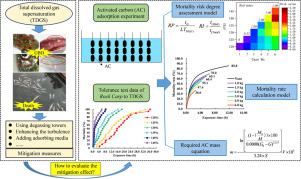Water Research ( IF 11.4 ) Pub Date : 2022-09-23 , DOI: 10.1016/j.watres.2022.119157 Youquan Yuan 1 , Chonglin Wang 1 , Jingjie Feng 1 , Zhenhua Wang 1 , Ran Li 1 , Yuanming Wang 1 , Kefeng Li 1

|
The proper water chemical composition of aquaculture water is very important for fish farming in reservoirs or fish multiplication stations. Gas bubble disease (GBD) is mainly caused by total dissolved gas supersaturation (TDGS) in water and is a common problem that affects the healthy growth of fish. Extensive measures have been taken to mitigate TDGS levels in water where fish live, while methods for quantitatively evaluating the mitigation effect of the proposed measures on fish exposed to TDGS are still lacking. In this paper, an activated carbon (AC) adsorption experiment for supersaturated total dissolved gas (TDG) dissipation was conducted, and the experimental results indicated that AC addition could effectively accelerate supersaturated TDG dissipation. Based on fish tolerance experiments conducted by Huang (2010), two models, including a mortality risk degree evaluation model and a mortality rate calculation model, were developed to quantitatively evaluate the mortality risk mitigation effect of AC addiction on fish exposed to unsteady TDGS levels. Application of the results of the mortality risk degree evaluation model has shown that AC addition can help alleviate the mortality risk of fish suffering from TDGS. Application of the results of the mortality rate calculation model has also demonstrated that the final mortality rate of the fish group in the case with AC addition was lower than that of the case without added AC, and the final mortality rate decreased as the specific surface area and dosage of AC increased. Furthermore, an equation that related the required AC mass and a given harvested fish mass was established. This paper provides a reference for evaluating the effects of various mitigation measures to alleviate the risk posed to fish by TDGS.
中文翻译:

基于利用活性炭缓解措施的鱼类总溶解气体过饱和死亡率风险评估方法
水产养殖水的适当水化学成分对于水库或鱼类繁殖站的养鱼非常重要。气泡病(GBD)主要由水中的总溶解气体过饱和度(TDGS)引起,是影响鱼类健康生长的常见问题。已经采取了广泛的措施来降低鱼类生活水中的 TDGS 水平,但仍缺乏定量评估拟议措施对暴露于 TDGS 的鱼类的缓解效果的方法。在本文中,进行了活性炭(AC)吸附过饱和总溶解气体(TDG)消散的实验,实验结果表明添加AC可以有效加速过饱和TDG消散。基于 Huang (2010) 进行的鱼类耐受性实验,两个模型,包括死亡风险程度评估模型和死亡率计算模型,用于定量评估AC成瘾对暴露于不稳定TDGS水平的鱼类的死亡风险缓解效果。死亡风险程度评估模型结果的应用表明,添加 AC 有助于减轻 TDGS 鱼类的死亡风险。应用死亡率计算模型的结果也表明,添加AC的情况下鱼群的最终死亡率低于未添加AC的情况,最终死亡率随着比表面积的增加而降低。和 AC 的剂量增加。此外,建立了一个方程,将所需的 AC 质量和给定的收获鱼质量联系起来。











































 京公网安备 11010802027423号
京公网安备 11010802027423号